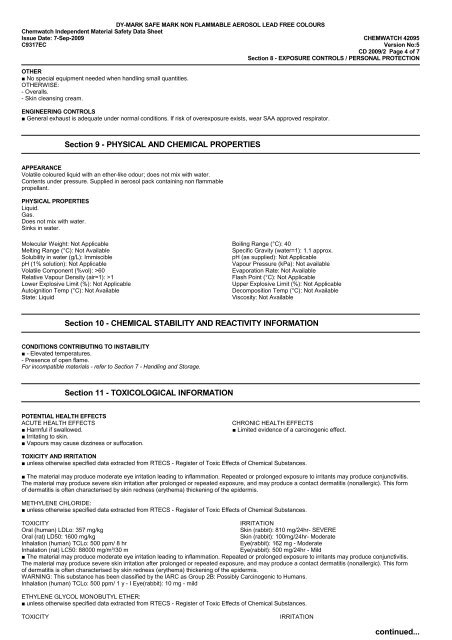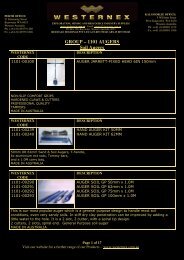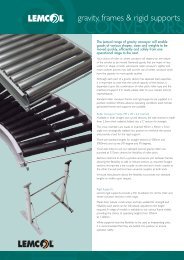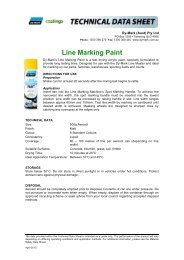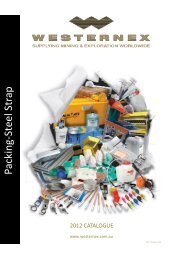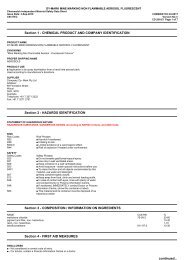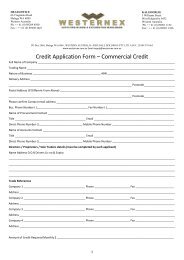Chemwatch Australian MSDS 42095 - Westernex
Chemwatch Australian MSDS 42095 - Westernex
Chemwatch Australian MSDS 42095 - Westernex
Create successful ePaper yourself
Turn your PDF publications into a flip-book with our unique Google optimized e-Paper software.
DY-MARK SAFE MARK NON FLAMMABLE AEROSOL LEAD FREE COLOURS<br />
<strong>Chemwatch</strong> Independent Material Safety Data Sheet<br />
Issue Date: 7-Sep-2009 CHEMWATCH <strong>42095</strong><br />
C9317EC<br />
Version No:5<br />
OTHER<br />
■ No special equipment needed when handling small quantities.<br />
OTHERWISE:<br />
- Overalls.<br />
- Skin cleansing cream.<br />
ENGINEERING CONTROLS<br />
■ General exhaust is adequate under normal conditions. If risk of overexposure exists, wear SAA approved respirator.<br />
CD 2009/2 Page 4 of 7<br />
Section 8 - EXPOSURE CONTROLS / PERSONAL PROTECTION<br />
Section 9 - PHYSICAL AND CHEMICAL PROPERTIES<br />
APPEARANCE<br />
Volatile coloured liquid with an ether-like odour; does not mix with water.<br />
Contents under pressure. Supplied in aerosol pack containing non flammable<br />
propellant.<br />
PHYSICAL PROPERTIES<br />
Liquid.<br />
Gas.<br />
Does not mix with water.<br />
Sinks in water.<br />
Molecular Weight: Not Applicable Boiling Range (°C): 40<br />
Melting Range (°C): Not Available<br />
Specific Gravity (water=1): 1.1 approx.<br />
Solubility in water (g/L): Immiscible<br />
pH (as supplied): Not Applicable<br />
pH (1% solution): Not Applicable<br />
Vapour Pressure (kPa): Not available<br />
Volatile Component (%vol): >60<br />
Evaporation Rate: Not Available<br />
Relative Vapour Density (air=1): >1<br />
Flash Point (°C): Not Applicable<br />
Lower Explosive Limit (%): Not Applicable<br />
Upper Explosive Limit (%): Not Applicable<br />
Autoignition Temp (°C): Not Available<br />
Decomposition Temp (°C): Not Available<br />
State: Liquid<br />
Viscosity: Not Available<br />
Section 10 - CHEMICAL STABILITY AND REACTIVITY INFORMATION<br />
CONDITIONS CONTRIBUTING TO INSTABILITY<br />
■ - Elevated temperatures.<br />
- Presence of open flame.<br />
For incompatible materials - refer to Section 7 - Handling and Storage.<br />
Section 11 - TOXICOLOGICAL INFORMATION<br />
POTENTIAL HEALTH EFFECTS<br />
ACUTE HEALTH EFFECTS<br />
■ Harmful if swallowed.<br />
■ Irritating to skin.<br />
■ Vapours may cause dizziness or suffocation.<br />
CHRONIC HEALTH EFFECTS<br />
■ Limited evidence of a carcinogenic effect.<br />
TOXICITY AND IRRITATION<br />
■ unless otherwise specified data extracted from RTECS - Register of Toxic Effects of Chemical Substances.<br />
■ The material may produce moderate eye irritation leading to inflammation. Repeated or prolonged exposure to irritants may produce conjunctivitis.<br />
The material may produce severe skin irritation after prolonged or repeated exposure, and may produce a contact dermatitis (nonallergic). This form<br />
of dermatitis is often characterised by skin redness (erythema) thickening of the epidermis.<br />
METHYLENE CHLORIDE:<br />
■ unless otherwise specified data extracted from RTECS - Register of Toxic Effects of Chemical Substances.<br />
TOXICITY IRRITATION<br />
Oral (human) LDLo: 357 mg/kg<br />
Skin (rabbit): 810 mg/24hr- SEVERE<br />
Oral (rat) LD50: 1600 mg/kg<br />
Skin (rabbit): 100mg/24hr- Moderate<br />
Inhalation (human) TCLo: 500 ppm/ 8 hr<br />
Eye(rabbit): 162 mg - Moderate<br />
Inhalation (rat) LC50: 88000 mg/m³/30 m<br />
Eye(rabbit): 500 mg/24hr - Mild<br />
■ The material may produce moderate eye irritation leading to inflammation. Repeated or prolonged exposure to irritants may produce conjunctivitis.<br />
The material may produce severe skin irritation after prolonged or repeated exposure, and may produce a contact dermatitis (nonallergic). This form<br />
of dermatitis is often characterised by skin redness (erythema) thickening of the epidermis.<br />
WARNING: This substance has been classified by the IARC as Group 2B: Possibly Carcinogenic to Humans.<br />
Inhalation (human) TCLo: 500 ppm/ 1 y - I Eye(rabbit): 10 mg - mild<br />
ETHYLENE GLYCOL MONOBUTYL ETHER:<br />
■ unless otherwise specified data extracted from RTECS - Register of Toxic Effects of Chemical Substances.<br />
TOXICITY<br />
IRRITATION<br />
continued...


